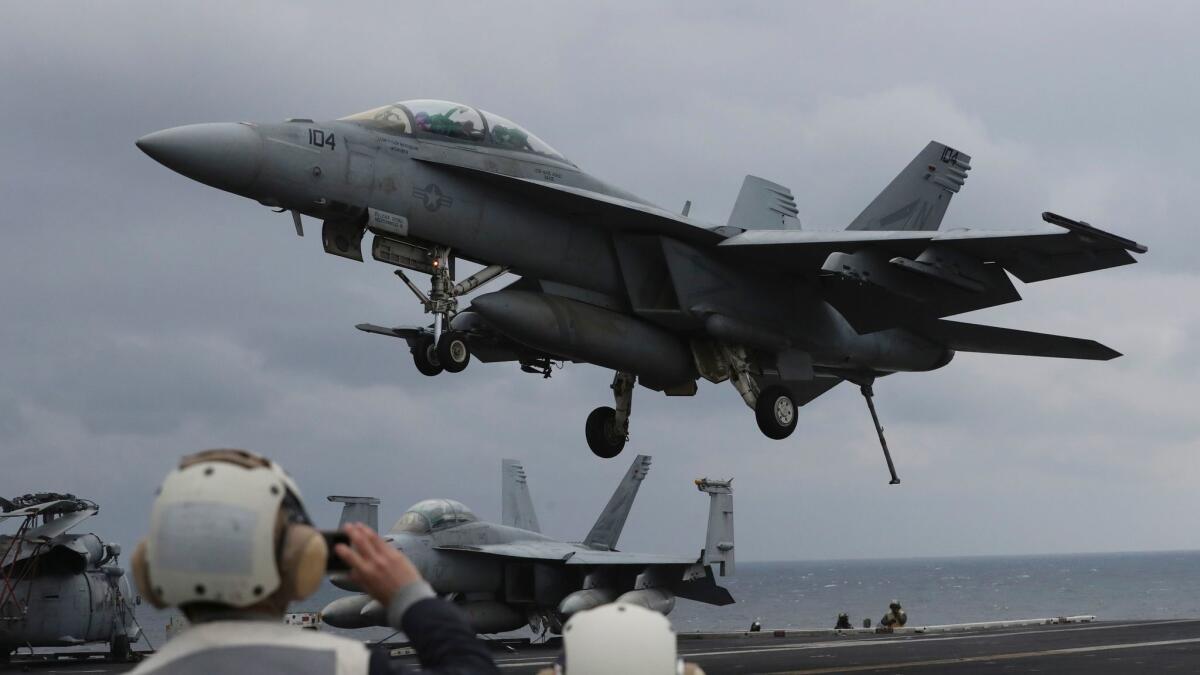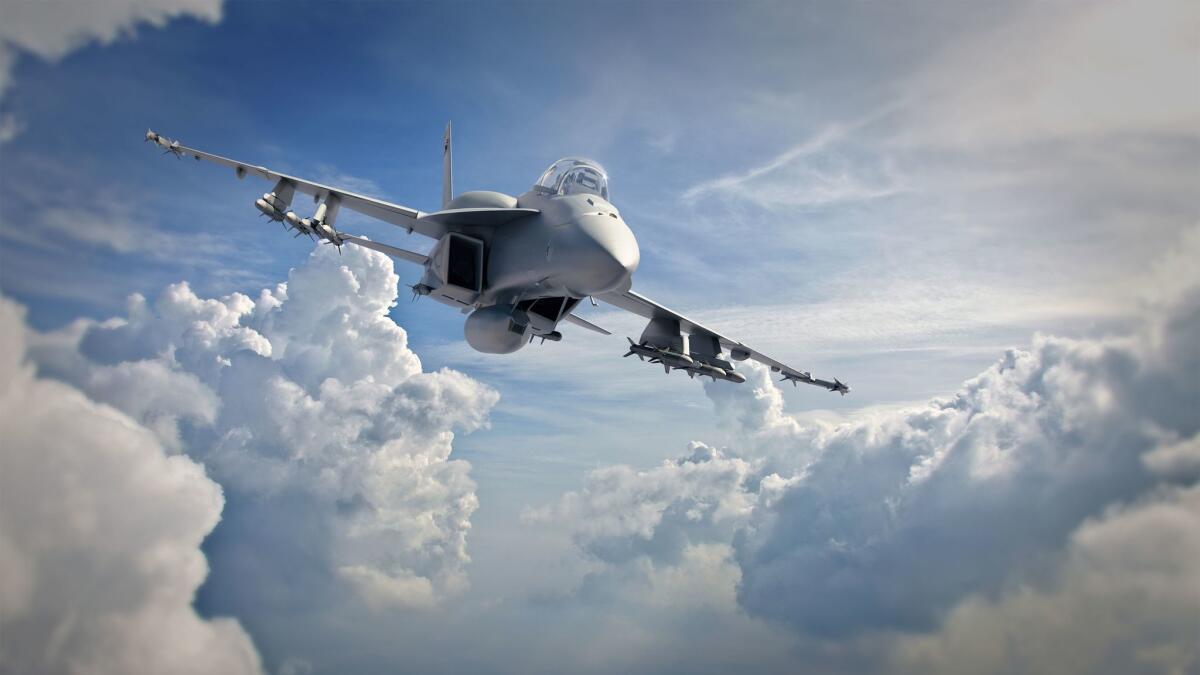Boeing hopes its Super Hornet fighter can emerge triumphant from Pentagon budget battle

- Share via
Since its inception nearly 40 years ago, the F/A-18 fighter family has come to dominate Navy carrier decks — and supported a base of more than 200 military contractors in Southern California. With a stealthy replacement rolling off assembly lines, though, its days seemed to be numbered.
Now, thanks to an unexpected lift from the Trump administration, the latest version of the fighter jet could catch a second wind.
President Trump has requested $2.32 billion for 24 new F/A-18 E/F Super Hornet aircraft in a supplemental budget request for fiscal year 2017. That comes after months of Trump tweets and talk about pricing out a “comparable” Super Hornet to compete with the new radar-resistant, sensor-packed F-35.
That request — and the Trump administration’s $54-billion proposed fiscal year 2018 defense spending increase — is subject to further budget negotiations in Congress and is far from assured.
“That assumes that they can get Congress to raise the budget caps for defense, and they pay for that in part by cutting the non-defense side of the budget,” said Todd Harrison, senior fellow at the Center for Strategic and International Studies. “The defense increase can’t happen if the Trump administration isn’t willing to compromise on some of the other budget issues.”
However, there is support in Congress to beef up the military, and the Navy brass intends to have a mix of F-35s and F/A-18s for years to come.
There’s also a simple matter of replacing worn-out planes. Navy officials have said 62% of its F/A-18s can’t fly because of maintenance needs due to constant use, a major reason that they are asking to buy more Super Hornets, Harrison said.
Meanwhile, the planes’ manufacturers continue to lobby. A report Thursday in trade publication Breaking Defense said F/A-18 maker Boeing Co. gave White House officials a paper with arguments for buying fewer of the Navy version of the F-35 and more Super Hornets, asserting that such a mix would be able to handle more battle tasks at a lower cost.
When asked about the report, Boeing said in a statement that “at the administration’s request, we have provided information about how Boeing can help address critical near-term naval aviation needs.”
The F/A-18 Hornet flew its first combat mission in the late 1980s. It made its mark in the early 1990s during the Gulf War, when four planes demonstrated their versatility by identifying and destroying two Iraqi aircraft in air-to-air combat before continuing on to complete their original ground bombing mission.
A major redesign of the F/A-18, known as the F/A-18 E/F Super Hornet, made its first flight in 1995. The upgraded plane is larger than its predecessor, with more powerful engines and increased range and payload capacity. There were more than 540 F/A-18 Super Hornets in the Navy’s inventory as of September. Boeing also has an electronic jamming derivative, the EA-18G Growler.
Half a dozen different aircraft that used to fly off carrier decks have been replaced by the Super Hornet.
— Loren Thompson, Lexington Institute
“When the Navy developed Super Hornet, it was looking for a versatile, tactical aircraft that could reduce the cost of maintaining its air fleet,” said Loren Thompson, military analyst at the Lexington Institute, which receives funding from Boeing and Lockheed Martin Corp., builder of the F-35.
“Half a dozen different aircraft that used to fly off carrier decks have been replaced by the Super Hornet,” Thompson said.
In recent years, Boeing has searched for ways to keep the F/A-18 line running.
In 2013, Boeing flew a prototype of a new version called the Advanced Super Hornet, designed to be less visible to radar with additions such as an enclosed weapons pod. The Chicago aerospace giant later changed course, deciding to build an upgrade called the Block 3 Super Hornet that would fill gaps in the Navy’s carrier air wing.
Shifting its focus from stealth, the new plane will have increased network capability to gather and share data with other planes like the F-35, as well as a new cockpit system with a touch-screen display and a sensor that can find and target threats without depending only on radar.
The Block 3 Super Hornet will no longer have the enclosed weapons pod from the Advanced Super Hornet design, but will still have fuel tanks that lay close to its body to increase range.
Those upgrade efforts seemed to pay off when Trump began targeting the cost of the F-35 Joint Strike Fighter, using the Super Hornet as a lower-cost foil.
In January, Defense Secretary James Mattis ordered a review comparing the operational capabilities of the Navy version of the F-35 with those of the Super Hornet. In a memo to the deputy secretary of Defense, Mattis said the review would assess whether an “advanced Super Hornet” could “provide a competitive, cost-effective, fighter aircraft alternative.” That review is still in progress.
At her nomination hearing Thursday before the Senate Armed Services Committee, Air Force Secretary nominee Heather Wilson seemed to offer support to the F-35 when she expressed doubt that stealth capability could be added “retroactively” to older planes.
Analysts say the Mattis review is likely to find that an improved Super Hornet will not have the stealth capabilities needed to replace the F-35C for the Navy.
“What the report will confirm is that Super Hornet is going to be in the Navy’s fleet until after 2040,” said Thompson of the Lexington Institute. “And the F-35 won’t so much replace the Super Hornet as just share responsibilities.”
Dan Gillian, F/A-18 and EA-18G program manager at Boeing, said the Block 3 Super Hornet is designed to work in a “complementary fashion” with the F-35.
Already, F-35 production delays have led to more Navy F/A-18 E/F orders to manage a shortfall of strike fighters.

In February, Boeing won a $678-million contract for seven Growlers and five Super Hornets. The company said in its 2016 annual report that as of Dec. 31 its backlog included 23 F/A-18 aircraft under contract with the Navy.
Gillian said the current rate of production is two Super Hornets per month, though that number could be increased to three a month to deal with the shortfall.
Boeing also is working on foreign orders for the Super Hornet for Kuwait and Canada, and has drawn interest from Finland, Switzerland and India. Many of the Block 3 capabilities are likely to be attractive to international customers, Gillian said.
Production on the new version of the Super Hornet, as well as upgrades to current F/A-18 E/F aircraft, could start as soon as the early 2020s, he said. Those new capabilities will be sourced through the same suppliers.
There are 274 F/A-18 suppliers in California and 20,000 jobs are tied to the program, according to Boeing.
More than 200 of those suppliers are in the southern part of the state. One, Brek Manufacturing Co. in Gardena, has machined parts for the F/A-18 program for more than 20 years, Boeing said.
Some of the largest suppliers are in El Segundo: Raytheon Co., which works on the plane’s radar and “conformal” fuel tanks; and Northrop Grumman Corp., which produces the rear and center section of the fuselage, the plane’s vertical tails, and integrates all the related systems.
Northrop Grumman’s approximately half-mile-long facility may be the longest redwood structure in the world; it dates to the early 1940s and was originally built to produce the Douglas SBD Dauntless dive bomber.
The company has delivered 2,229 fuselages to Boeing as of March 15.
“The brains of the airplane — the ability to think, the ability to shoot, the ability to maneuver — and more importantly, the sensors, the ability to see, that’s California-based technology,” said Jack Cronin, partner at Fairmont Consulting Group in Boston.
More turbulence could be ahead. Future U.S. military aircraft orders for fiscal year 2018 will depend on the budget that eventually emerges from Congress. Increasing defense spending, as Trump has requested, will require 60 votes in the Senate to raise the budgets caps that were last modified two years ago, said Harrison of the Center for Strategic and International Studies.
Essentially re-litigating the 2015 budget deal could be a “hard deal to broker,” he said.
“What they had to do last time is they had to give increases on the non-defense side of the budget, which is exactly the opposite of what Trump is proposing,” Harrison said.
Twitter: @smasunaga
ALSO
SpaceX launches first recycled rocket as CEO Elon Musk seeks 1-day turnaround
Once the queen of the skies, the 747 will soon be just a flying truck
The new rocket from Jeff Bezos’ space company has its first customer
More to Read
Inside the business of entertainment
The Wide Shot brings you news, analysis and insights on everything from streaming wars to production — and what it all means for the future.
You may occasionally receive promotional content from the Los Angeles Times.











